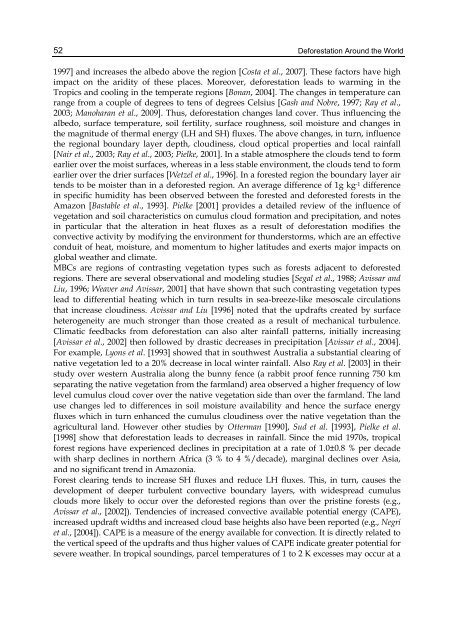DEFORESTATION AROUND THE WORLD - India Environment Portal
DEFORESTATION AROUND THE WORLD - India Environment Portal
DEFORESTATION AROUND THE WORLD - India Environment Portal
You also want an ePaper? Increase the reach of your titles
YUMPU automatically turns print PDFs into web optimized ePapers that Google loves.
52<br />
Deforestation Around the World<br />
1997] and increases the albedo above the region [Costa et al., 2007]. These factors have high<br />
impact on the aridity of these places. Moreover, deforestation leads to warming in the<br />
Tropics and cooling in the temperate regions [Bonan, 2004]. The changes in temperature can<br />
range from a couple of degrees to tens of degrees Celsius [Gash and Nobre, 1997; Ray et al.,<br />
2003; Manoharan et al., 2009]. Thus, deforestation changes land cover. Thus influencing the<br />
albedo, surface temperature, soil fertility, surface roughness, soil moisture and changes in<br />
the magnitude of thermal energy (LH and SH) fluxes. The above changes, in turn, influence<br />
the regional boundary layer depth, cloudiness, cloud optical properties and local rainfall<br />
[Nair et al., 2003; Ray et al., 2003; Pielke, 2001]. In a stable atmosphere the clouds tend to form<br />
earlier over the moist surfaces, whereas in a less stable environment, the clouds tend to form<br />
earlier over the drier surfaces [Wetzel et al., 1996]. In a forested region the boundary layer air<br />
tends to be moister than in a deforested region. An average difference of 1g kg -1 difference<br />
in specific humidity has been observed between the forested and deforested forests in the<br />
Amazon [Bastable et al., 1993]. Pielke [2001] provides a detailed review of the influence of<br />
vegetation and soil characteristics on cumulus cloud formation and precipitation, and notes<br />
in particular that the alteration in heat fluxes as a result of deforestation modifies the<br />
convective activity by modifying the environment for thunderstorms, which are an effective<br />
conduit of heat, moisture, and momentum to higher latitudes and exerts major impacts on<br />
global weather and climate.<br />
MBCs are regions of contrasting vegetation types such as forests adjacent to deforested<br />
regions. There are several observational and modeling studies [Segal et al., 1988; Avissar and<br />
Liu, 1996; Weaver and Avissar, 2001] that have shown that such contrasting vegetation types<br />
lead to differential heating which in turn results in sea-breeze-like mesoscale circulations<br />
that increase cloudiness. Avissar and Liu [1996] noted that the updrafts created by surface<br />
heterogeneity are much stronger than those created as a result of mechanical turbulence.<br />
Climatic feedbacks from deforestation can also alter rainfall patterns, initially increasing<br />
[Avissar et al., 2002] then followed by drastic decreases in precipitation [Avissar et al., 2004].<br />
For example, Lyons et al. [1993] showed that in southwest Australia a substantial clearing of<br />
native vegetation led to a 20% decrease in local winter rainfall. Also Ray et al. [2003] in their<br />
study over western Australia along the bunny fence (a rabbit proof fence running 750 km<br />
separating the native vegetation from the farmland) area observed a higher frequency of low<br />
level cumulus cloud cover over the native vegetation side than over the farmland. The land<br />
use changes led to differences in soil moisture availability and hence the surface energy<br />
fluxes which in turn enhanced the cumulus cloudiness over the native vegetation than the<br />
agricultural land. However other studies by Otterman [1990], Sud et al. [1993], Pielke et al.<br />
[1998] show that deforestation leads to decreases in rainfall. Since the mid 1970s, tropical<br />
forest regions have experienced declines in precipitation at a rate of 1.0±0.8 % per decade<br />
with sharp declines in northern Africa (3 % to 4 %/decade), marginal declines over Asia,<br />
and no significant trend in Amazonia.<br />
Forest clearing tends to increase SH fluxes and reduce LH fluxes. This, in turn, causes the<br />
development of deeper turbulent convective boundary layers, with widespread cumulus<br />
clouds more likely to occur over the deforested regions than over the pristine forests (e.g.,<br />
Avissar et al., [2002]). Tendencies of increased convective available potential energy (CAPE),<br />
increased updraft widths and increased cloud base heights also have been reported (e.g., Negri<br />
et al., [2004]). CAPE is a measure of the energy available for convection. It is directly related to<br />
the vertical speed of the updrafts and thus higher values of CAPE indicate greater potential for<br />
severe weather. In tropical soundings, parcel temperatures of 1 to 2 K excesses may occur at a

















